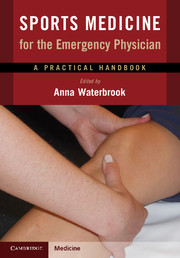Book contents
- Half title page
- Title page
- Copyright page
- Contents
- Contributors
- Book part
- Introduction
- Chapter 1 Shoulder
- Chapter 2 Elbow
- Chapter 3 Wrist
- Chapter 4 Hand
- Chapter 5 Pelvis, Hip, and Thigh
- Chapter 6 Knee
- Chapter 7 Lower Leg and Ankle
- Chapter 8 Foot
- Chapter 9 Cervical Spine
- Chapter 10 Lumbar Spine
- Chapter 11 Concussion
- Chapter 12 Arrhythmias and Sudden Cardiac Arrest in Athletes
- Chapter 13 Exertional Heat Illness
- Chapter 14 Basic Principles of Splinting in the Emergency Department
- Index
- References
Chapter 12 - Arrhythmias and Sudden Cardiac Arrest in Athletes
Published online by Cambridge University Press: 05 May 2016
- Half title page
- Title page
- Copyright page
- Contents
- Contributors
- Book part
- Introduction
- Chapter 1 Shoulder
- Chapter 2 Elbow
- Chapter 3 Wrist
- Chapter 4 Hand
- Chapter 5 Pelvis, Hip, and Thigh
- Chapter 6 Knee
- Chapter 7 Lower Leg and Ankle
- Chapter 8 Foot
- Chapter 9 Cervical Spine
- Chapter 10 Lumbar Spine
- Chapter 11 Concussion
- Chapter 12 Arrhythmias and Sudden Cardiac Arrest in Athletes
- Chapter 13 Exertional Heat Illness
- Chapter 14 Basic Principles of Splinting in the Emergency Department
- Index
- References
- Type
- Chapter
- Information
- Sports Medicine for the Emergency PhysicianA Practical Handbook, pp. 367 - 389Publisher: Cambridge University PressPrint publication year: 2016



